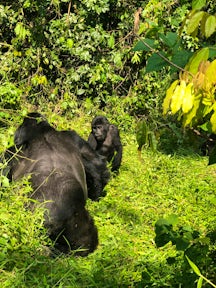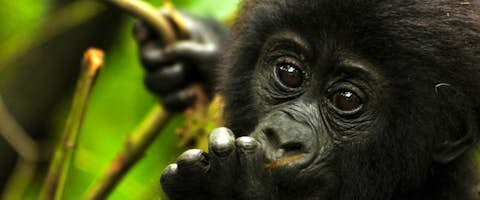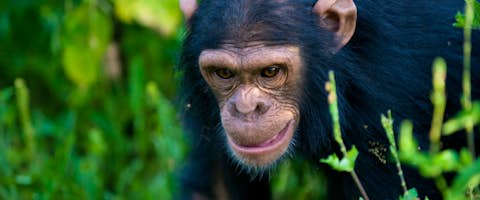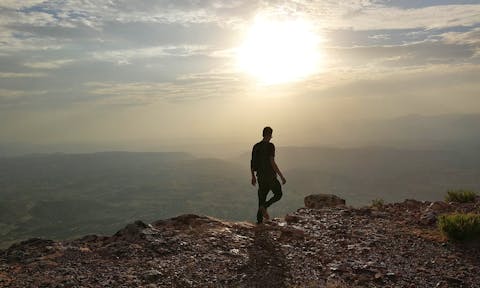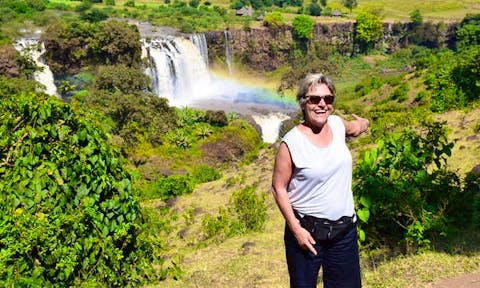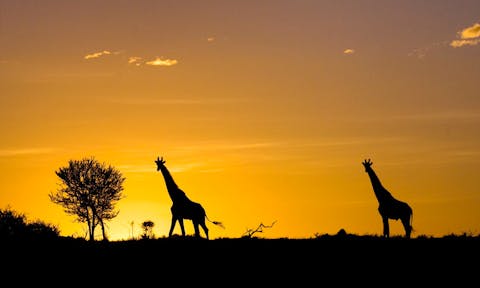Mgahinga Gorilla National Park, at a glance
Mgahinga is Uganda’s smallest national park - just 34 km². The park is breathtakingly beautiful. Behind the dramatic volcanic skyline, in front Bwindi Impenetrable Forest and to the left of Mutanda and Bunyonyi - lakes so scenic you can’t believe more people don’t know about them - Mgahinga is at the frontier of Uganda's wilderness experiences.
The montane-woodland, montane-forest and large swathe of bamboo forests supports a large population of golden monkeys, found only here in Uganda. They are also home to the Nyakagazi family of mountain gorillas, the only habituated group outside of Bwindi.
Traditionally, Mgahinga was used as an ‘over-flow’ gorilla tracking destination for Bwindi, but that has changed for two reasons. The first is that the increase in the cost of Rwandan gorilla permits to $1,500 per person has prompted visitors to explore Rwanda and then nip across the border to Mgahinga where the treks cost $700 per person (at time of writing).
The second reason is that Mgahinga is such a wonderful place to visit. Situated so closely to Mutanda and Bunyoni lakes that you can spend a week in the far southwest and save the rest of Uganda for a second trip.
In addition to gorilla treks and golden monkey excursions - both a standard visit and the longer habituation experiences - Mgahinga is an excellent general trekking destination. Challenging guided day hikes are available to the summits of all three of the mountains accessible from Uganda: Gahinga, Sabyinyo and Muhabura.

Things to do in Mgahinga
Gorilla Trekking
The gorilla trekking in Mgahinga follows the same model as in Bwindi. Treks depart in the morning at about 9am. The length of the trek before you make contact with the gorillas depends on the location of the gorilla family. Contact lasts for one hour, during which you will be about 7 metres from the gorillas. When the hour has elapsed, you return through the forest to Park HQ, normally returning by early afternoon.
Although gorilla families constantly cross the border from Rwanda to Uganda, there is only one family habituated to make contact in Mgahinga. Called the Nyakagazi group, it has five silverbacks, two adult females and three young gorillas.
Between 2004 and 2012, after being attacked by a lone silverback, the family spent most of the time on the Rwanda side of the border. However, since 2012, they have been a regular presence on the Ugandan side. In the event they move again after permits have been bought, the Ugandan Wildlife Authority has committed to moving the treks to Bwindi or refunding the money.
Like in Bwindi, Mgahinga gorilla treks can be tough and challenging experiences. You need to be physically and mentally prepared and adequately dressed. Get that right, and you will enjoy one of the most memorable wildlife experiences in the world.
Golden Monkey Tracking and Habituation
Golden monkeys are large, inquisitive and mischievous old world monkeys found in the bamboo zone of the Virunga Volcanoes. They have a bright orange-gold body, cheeks and tail, with black limbs, crown and tail-end.
The monkeys range through the bamboo forest looking for food. Now used to human visitors, they continue their foraging and playful interactions without pause.
Found above 2,500 metres, the trek is challenging, but not normally as tough as gorilla tracking. Two versions are available: the standard trek with one hour contact and a habituation trek where you spend much longer on the mountain with the research team.
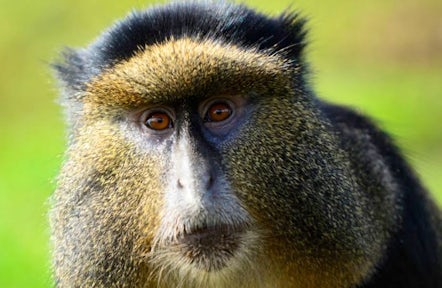
Guided Treks
For those spending more than a couple of nights in Mgahinga, there are great guided trekking trails available, which take you high up the mountains. The treks depart daily at about 7:30 and all last from 7 to 9 hours depending on the fitness and interest of the trekkers.
The shortest route is the 1,100-metre climb from the park gate to Gahinga’s peak. The route to Sabyinyo’s peak involves a 1,300-metre climb on an 8-hour round route. Climbers should note that the final approach to the summit uses a ladder climb up three consecutive rock faces.
The greatest climb is to the 4,127m summit of Muhabura Peak. Hikers should look out for symptoms of high altitude sickness following an ascent of 1,793m from the trailhead. No rock faces are involved, but the trek does take grit and determination as you trudge across Afro-montane moorland.

Geography & Geology
The peaks of Mgahinga are extinct volcanoes that form part of the Virunga Massif. The altitude ranges from 2,227m to 4,127m above sea level. The park is 34km² and was gazetted in 1991, having been protected as a Game Sanctuary since 1930.
Temperature varies depending on altitude, but it averages 20 degrees Celsius during the day and 9 degrees during the night at the lower slopes. For every 1,000 metres increase in altitude, the temperature drops 6 degrees Celsius.

Bwindi’s annual rainfall ranges from 1,400 to 1,900mm.
Flora & Fauna
The park is small and much of the original Afro-montane forest has been lost to felling and cultivation, but the biodiversity remains high.
There are 76 recorded mammal species. The most charismatic of these is the mountain gorilla and the golden monkey. One gorilla family is habituated, but several move between Uganda and Rwanda. The golden monkey, a playful and distinctive species found only in the Virungas numbers between 3,000 and 4,000, with about 60 being habituated to human contact in Mgahinga. Other notable species are black and white colobus monkey, leopard, elephant, giant forest hog, bushpig, black-fronted duiker, and buffalo.
Avifauna is less diverse, with a current species list of 115 birds.
The list includes the Ibis, Pin-tailed Whydah, Speckled Mousebird, Stone Chat, Grey-capped Warbler, Wax Bills, Yellow-vented Bulbul, Firefinch, White-naped Raven, Black Kite, Rwenzori Turaco, Blue-headed Coucal, Paradise Fly-catcher, Rwenzori Batis, Double-collared Sunbird, Rwenzori Nightjar. Of these, several are localised forest specialists and 12 are Albertine Rift endemics.

Getting to Mgahinga National Park
Mgahinga is 14km on rough roads from the town of Kisoro, the entry point to southern Bwindi.
Kisoro is best accessed using a scheduled light aircraft flight from Entebbe. Daily departures take about 90 minutes.
Alternatively, Kisoro can be reached by road from Entebbe/Kampala - a long day drive of 10 hours or 5/6 hours from Lake Mburo National Park.
When to Visit Mgahinga
Due to Uganda’s equatorial position and an increasingly variable climate, you should always expect rain when visiting Uganda. However, the heaviest rainfall normally occurs from mid- March to the end of May and then again at the end of September through to November. While the rains in March to May are often short, those in September to November are more often characterised by hours of soft drizzle.
Gorillas can be tracked at any time of year, but it does become harder when the trails are mud-slides and water is running down your neck, soaking you through. So the most popular times to track the gorillas is the drier months of June to mid-September and December, January and February.
But don’t discount the ‘rainy season’. Permits are easier to come by at relatively short notice and there is something exhilarating about sitting, mud-covered and uncaring, among a group of gorillas, feeling like you are the only people in the forest.
Places to Stay at Mgahinga
There is only one tourist lodge currently available in Mgahinga, the luxurious Mount Gahinga Lodge. Sister property to Volcanoes Bwindi and Kyambura Gorge, the lodge is a stylish and comfortable option located just a few hundred metres from the park gate.
Lovely gardens brings the wildlife to your door. The lodge has also done incredible work supporting the local Batwa community evicted from the forests when the Park was gazetted. They have built a village, established a cultural centre, helped run a dance group - with the aim of aiding the integration of the Batwa with the other local communities - and begun a vocational training centre.
Further afield, Mgahinga is accessible from lodges on Lake Mutanda like Chameleon Hill and on Lake Bunyonyi like Bird's Nest.
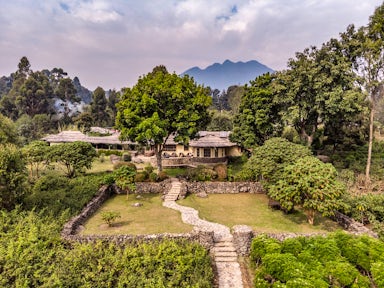
The landscapes inspire the design of many Ugandan lodges.
Popular Trips to Uganda
The tours below showcase just some of what is possible. Use these itineraries as starting points, or to draw inspiration. Then get in touch, and let our expert team help craft the perfect itinerary for you.
Thinking about visiting Uganda?
Listen
We'll spend some time listening to your aspirations, then discuss the kind of experience that might suit you.
Match
Next we'll discuss the options, shortlist the best trips for you and present you our impartial recommendations.
Reserve
We'll place a 24 hour hold on your preferred option - without obligation - whilst we talk through the details.
Get in touch and we can help you understand your options, design an itinerary that's right for you, and then get you set up and ready to go.
+1 315 645 2889


